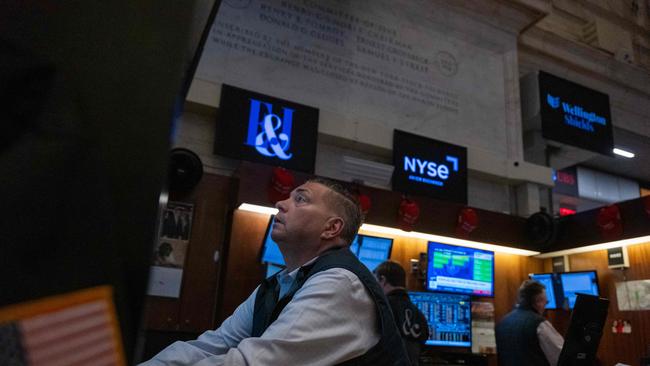JPMorgan warns of sharemarket correction
The worst month for equity fund flows since the end of 2022 ‘portrays a picture of fragility rather than resilience’ in terms of retail investors’ impulse into equities, JPMorgan warns.

JPMorgan sees signs of fragility in the US stock market, even after a strong rebound in the face of sticky inflation data that pushed back against rate cut expectations.
Despite the recession fears that were evident when the S&P 500 tumbled 4.4 per cent after disappointing manufacturing and jobs data last week, the US benchmark rebounded 2.7 per cent from a three-day low on Wednesday after core inflation rose slightly more than expected.

Commodity prices and bond yields have dived, and a nascent “dis-inversion” of the US bond yield curve has fuelled recession fears. But the share market is still looking for a soft landing, even if sticky inflation dissuades the Fed from starting its easing cycle with a jumbo-sized 50 basis points cut.
A dovish speech by Fed chair Jerome Powell at the Jackson Hole central bankers’ conference last month looks to be resonating with investors in terms of the so-called “Fed put” argument.
While monthly core CPI inflation rose slightly more than expected, investors still expect rate cuts to start this month after Mr Powell said inflation risks had “diminished” and jobs risks had “increased”.
Mr Powell said the Fed will do “everything” it can to support the labour market. With the Fed funds rate target now at 5.25-5.0 per cent, he said the Fed has “ample room to respond to any risks we may face, including the risk of unwelcome further weakening in labour market conditions.”
But to a large extent, the US stock market continues to be driven by Nvidia.
The $US2.87 trillion ($4.28bn) AI chip giant rose 8.2 per cent on Wednesday after falling 20 per cent in two weeks after its results and outlook didn’t beat expectations by quite as much as usual.
The rebound in Nvidia came as CEO Jensen Huang talked up demand for its chips at a Goldman Sachs conference. As such, the rise in Nvidia looked to be driven by what may be a temporary lift in market sentiment rather than an improved outlook that warrants an upgrade of earnings expectations.
Nvidia shares are up 136 per cent so far in 2024 after soaring 239 per cent in 2023.
Meanwhile, data released over the past week from monthly reporting funds saw a much worse equity fund flow for August relative to initial data from weekly reporting funds, which “points to abrupt downshifting of the retail impulse into equities”, according to JPMorgan.
The release of equity mutual fund and ETF flows by monthly reporting funds changed the picture for August to one of “fragility” rather than “resilience”.
While initial data by weekly reporting funds saw equity fund inflows for most weeks during August, the monthly reporting equity fund flows were a lot more negative, changing the estimate for August to an outflow of $US55bn globally based on Lipper data of monthly reporting funds.
It was in sharp contrast to the picture from weekly reporting funds of net inflows this year.
“This makes August 2024 the worst month for equity fund flows since the end of 2022 and portrays a picture of fragility rather than resilience in terms of retail investors’ impulse into equities,” said JPMorgan’s head of global markets strategy Nikolaos Panigirtzoglou.
“In our opinion, a weaker retail impulse raises the risk of a more severe equity market correction going forward given the lack of new positive catalysts beyond a temporary positive equity rebalancing flow over the coming two weeks and the resurfacing of US recession fears and the uncertainty ahead of the US election,” he said.

Mr Panigirtzoglou estimates that there will be around $US125bn of buying of both stocks and bonds related to rebalancing flows from multi-asset investors before the end of the month and quarter.
But after this month, the abrupt downshifting in the retail impulse poses downside for equities.
He also compared the past month in equity markets to the movements that occurred before the start of past Fed interest rate cutting cycles and Presidential elections.
On the first point, he found it has more closely tracked the trajectories of previous Fed rate cut cycles outside US recessions than the trajectories of previous Fed rate cut cycles during US recessions.
In other words, the market patterns so far have been more consistent with anticipating a Fed rate cut cycle with no recession, but that doesn’t mean there won’t be a recession.
Beyond next week’s expected first Fed rate cut, Mr Panigirtzoglou says the historic patterns point to further downside in US Treasury yields, a steeper curve, a weaker S&P 500 at least in the near term, little changed credit spreads and a stronger dollar over the medium term.
“If a recession takes place, the downside to equities would extend to between three-to-six months, while credit spreads would rise significantly over the coming year,” he said.
Market action has also been more consistent with expectations of Democrat nominee Kamala Harris winning the election but Republicans winning Congress, which “would entail more limited policy changes and have little implications for markets.”
As for the recent dis-inversion of the yield curve, he found that in the 1980 and 1981 recessions that this only occurred after the formal start of the recession, whereas in the 1990, 2001 and 2007 recessions it happened three, two and six months before the start of the recession.
“Of these, if a recession does indeed take hold in the coming quarters, the lack of private sector debt imbalances and the frothy and tech-heavy nature of the equity rally could suggest the 2001 cycle would have the greatest similarities,” Mr Panigirtzoglou said.
In that cycle, the dis-inversion took place around two months before the eventual recession.
More Coverage
Originally published as JPMorgan warns of sharemarket correction





